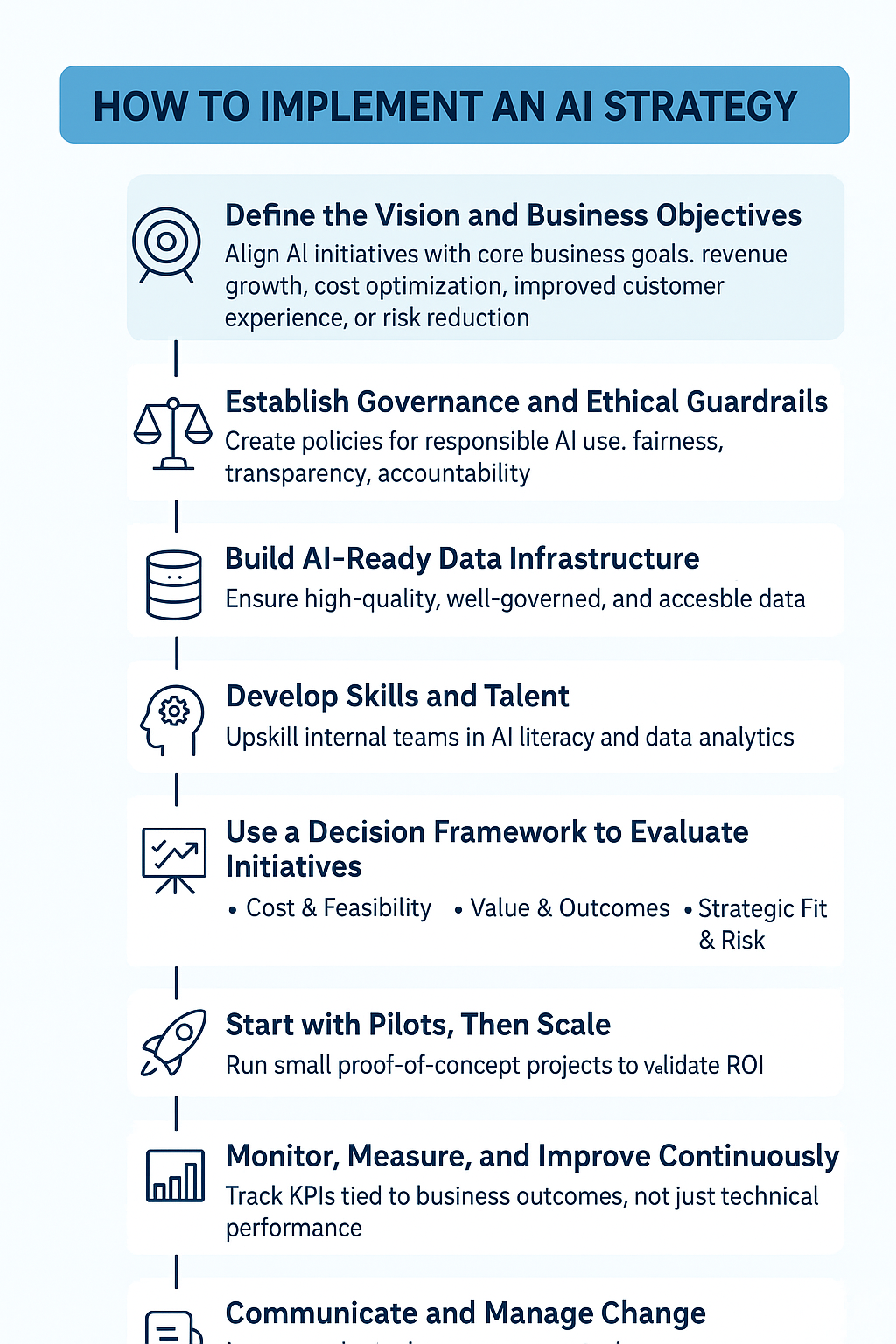OAS EXPLAINS: HOW TO DEVELOP A STRUCTURED APPROACH TO IMPLEMENTING AN AI STRATEGY

This article highlights the necessary steps in order to develop and implement an Ai Strategy. The post also lists both the benefits and the dangers associated by each step.
Steps to Implement an AI Strategy
Define Business Objectives
- Benefit - Aligns AI with measurable goals like revenue growth, operational efficiency, and customer experience.
- Dangers- AI adoption without a clear purpose risk wasted investments and “shiny object” syndrome.
Every AI strategy must begin by translating broad business goals into specific, measurable AI objectives. For example, improving customer satisfaction by automating support workflows or increasing operational efficiency through predictive maintenance.
Articulating a clear vision ensures all stakeholders understand why AI is being adopted and what success looks like
Ensure Responsible AI Governance
- Benefits - Builds trust with customers, regulators, and employees.
- Dangers: Lack of governance can lead to bias, compliance failures, and reputational damage.
Robust governance structure ensures AI initiatives remain aligned with regulations, ethics, and risk tolerance:
- Form an AI steering committee drawn from business, IT, legal, and compliance teams.
- Create policies for data privacy, model validation, bias detection, and security.
- Define clear ownership of AI assets and processes for ongoing oversight and audits.
Build AI-Ready Infrastructure
- Benefits - Clean, governed, and centralized data improves model accuracy and scalability.
- Dangers - Poor data quality or fragmented systems undermine AI outcomes and create hidden costs.
AI thrives on high-quality data and scalable compute:
- Centralize or federate data into a governed data platform (lake or warehouse).
- Invest in MLOps tools to automate model development, testing, deployment, and monitoring.
- Leverage cloud services or on-premise GPU clusters based on latency, cost, and compliance needs.
Develop a Talent & Skills and actionable Roadmap
- Benefits - Equips teams with AI literacy and supports adoption across the enterprise.
- Dangers - Overreliance on external vendors or lack of training widens the skills gap.
Translate strategic goals into an actionable plan:
- Ensure that the organization possesses the required skills and talent to tackle the task effectively. Additionally, outline milestones for pilot launches, production deployments, and enterprise rollouts.
- Assign resources and cross-functional support for each phase.
- Define key performance indicators (KPIs) such as time-to-market, model accuracy, and ROI metrics to track progress.
Evaluate Costs vs. Value with a Decision Framework
- Benefits -Helps prioritize projects with the highest ROI and lowest risk.
- Dangers - Underestimating ongoing costs (monitoring, retraining models, security) can erode value.
Pilot → Scale
- Benefits -Small wins prove value quickly and build confidence.
- Dangers - Scaling too fast without proof points can cause technical debt and cultural resistance.
Testing in controlled pilots helps refine approaches before full scale:
- Start small to validate assumptions on data quality, model performance, and user adoption.
- Collect quantitative and qualitative feedback, adjusting model parameters and workflows accordingly.
- Scale successful pilots by standardizing processes and embedding AI capabilities into core systems.
Continuous Monitoring & Improvement
- Benefits - Ensures AI remains effective, ethical, and compliant as business and regulations evolve.
- Dangers - Neglecting model drift, cyber risks, or changing laws can expose the organization to failures or penalties.
AI is a dynamic field that demands ongoing refinement:
- Implement automated monitoring to catch model drift, data anomalies, or performance regressions.
- Schedule regular reviews to retrain models with fresh data and optimize algorithms.
- Foster a culture of experimentation where teams continuously propose, test, and share new AI innovations.
Benefits of Implementing AI
- Improved decision-making through predictive insights.
- Automation of repetitive processes → cost savings.
- Enhanced customer personalization and experience.
- Better fraud detection, risk management, and compliance monitoring.
- Competitive differentiation and new business models.
Possible Dangers of AI
- Data privacy breaches and cybersecurity risks.
- Bias and unfair decision-making from flawed training data.
- Overhype leading to unrealistic expectations.
- Workforce resistance or disruption due to automation.
- Regulatory fines or legal action for non-compliance.
Implementation Strategy at a glance

The most effective AI strategies maximize business value while actively managing risks through governance, transparency, and continuous adaptation.